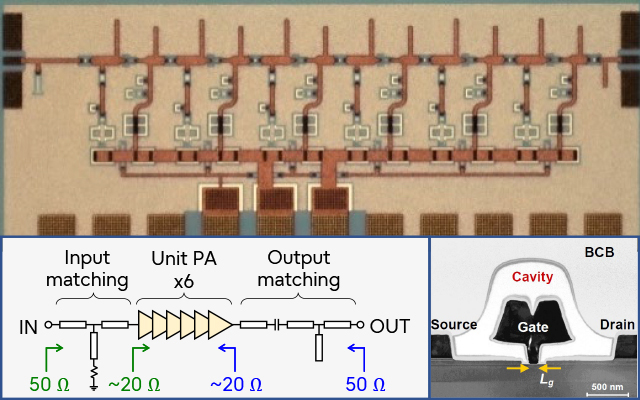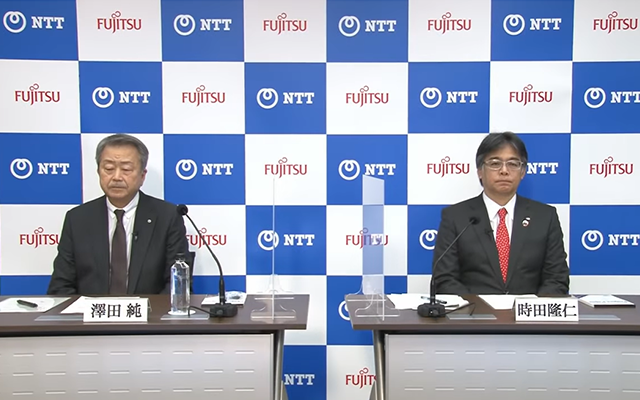R&D activities for 6G
Fujitsu’s Initiatives for carbon neutrality in the network services/systems
JapaneseIssues for carbon neutral society
As both smartification and digitization are progressing in several sectors, more than 100 billion IOT devices will be connected to ICT infrastructure in 2030. These IOT devices is expected to be seen not only in current common usage like the censor devices, but also in lots of use cases, such as XR technology requiring large-volume and real-time data communication, remote medical service with high-definition image, remote operation in industry and remote operation of construction machinery. By 2030, accelerating data traffic due to the rapid increase of connections will result in more than 30 times IP traffic and 2 times power consumption of network related facilities compared with in 2018.*1 Moreover, power consumption in ICT sector is increasing because more computing resources are required for enabling rapid and efficient processing/analysis of enormous data.
Therefore, to mitigate the environmental impact, actions for reducing the power consumption of ICT through innovative technology, such as the densification of devices and AI technology, is essential.
Fujitsu's Initiatives 1 : Reduction of power consumption in communications networks
Fujitsu is promoting its activities for the reduction of power consumption in hardware, software and whole network based on the open & disaggregation technology of network by developing environment-friendly products and services in wireless system and optical transport system.

Hardware
Power saving of Radio Unit(RU) hardware
Fujitsu is targeting the drastic improvement of energy-efficiency in the operation of RU by environment-friendly hardware, such as highly efficient amplifier technology and the advanced technology for dynamic and optimal reallocation of radio resources according to the status of communication traffic.
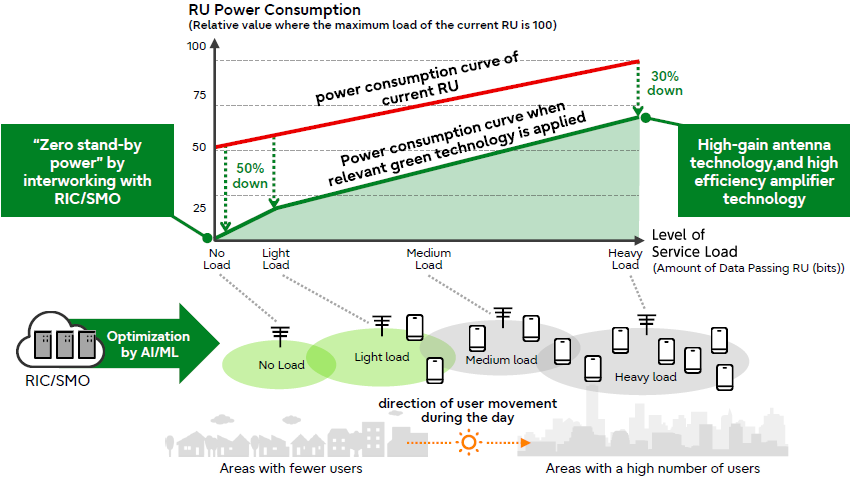 Power saving of RU
Power saving of RU
Power saving of optical transmission system
In the optical transport network, significant reduction of energy consumption per bit of transmission data is pursued by low power consumption LSI for high-capacity system.
 Development of optical transmission systems, subsystems and optical devices for the 5G-Advanced era
Development of optical transmission systems, subsystems and optical devices for the 5G-Advanced era

Software
In the software, power consumption is expected to be minimized by sharing network resources on the cloud with software base station (virtualized Centralized Unit (CU)/ Distributed Unit (DU) ) which can work on general hardware.*2 It leads to the reduction of environmental impact.
As it is difficult to optimize the performance on software-defined base station compared with conventional hardware appliance, it is essential to increase the number of cells which can be accommodated in a base station by maximizing the hardware virtualization capability of GPU. By incorporating this technology into general-purpose servers, satisfactory level of function can be achieved through the increase of accommodated cells without increasing the number of general-purpose servers.
On the other hand, in the areas where high-grade function is not required, same technology can run the software base station on more compact-sized general-purpose servers, and it achieves lower power consumption than by dedicated devices. Therefore, regardless the size of base station, this technology contributes to energy-efficiency on whole base stations with realizing optimal power use based on the situation of each area.
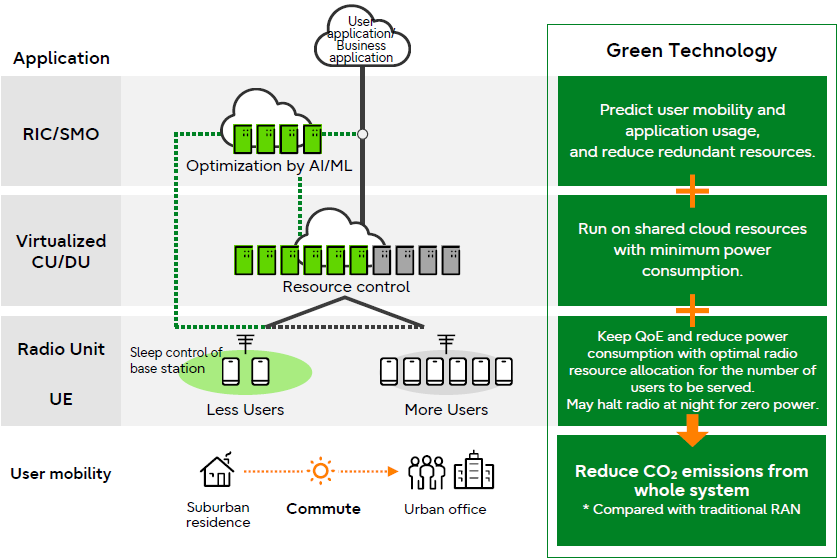 Reducing power consumption by network resource control
Reducing power consumption by network resource control

Network
As for the entire network, low power consumption will be realized through efficient operation in accordance with the use status of users by AI/ML for optimal management control.
Predictive network resource scaling
In the area of RAN, containerization of software base-defined stations enables flexible network operations that take advantage of the characteristics of the cloud, such as smooth scale-out when required. With zero touch autoscaling to solve resource constraints in the cloud, necessary resources can be utilized at any time, and it leads to reduction of reserved resource. This makes it possible to reduce the number of devices that is no longer needed and save the power consumption. This resource management is realized by automatic scaling technology that automatically adds and deletes containerized base stations in accordance with the communication load conditions by highly precise operation of RIC using AI/ML.
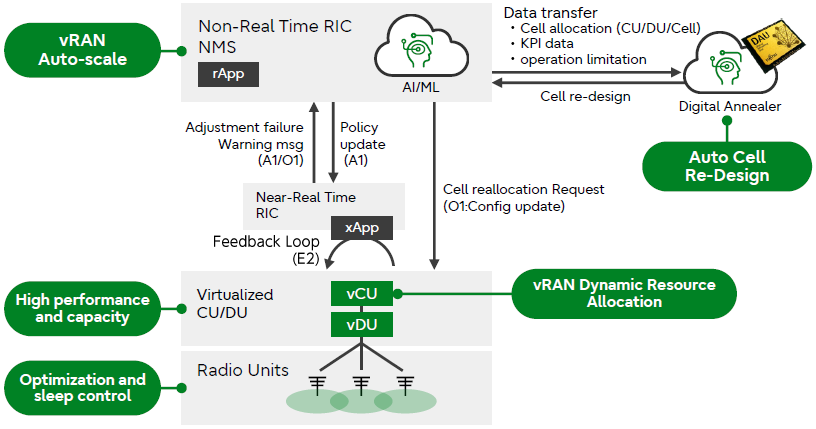 Base station autoscaling with containerization technology
Base station autoscaling with containerization technology
Advanced architecture of optical transport systems
Effort for reducing power consumption is being made not only in RAN but also in optical transport networks by using SDN controllers for overall control of network operation.
In optical transport system, overall control with optical SDN controllers is realized for building flexible networks connecting disaggregated functions (WDM, transport, switch, etc.). This enables both agile network construction with optimal combinations and the reduction of power consumption in whole network.
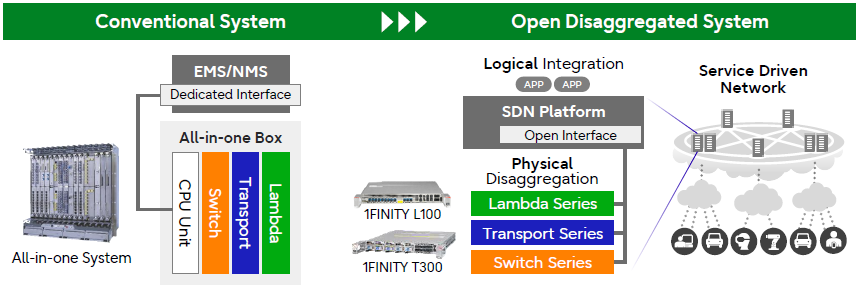 Overall control by SDN controller
Overall control by SDN controller
Fujitsu's Initiatives 2 : Lifecycle management of network equipment
Fujitsu is working for the reduction of power consumption not only during product operation, but also throughout the product lifecycle (product design, material selection, manufacturing, distribution, disposal, etc.).
Product lifecycle management
In the product lifecycle, products are designed to achieve the reduction of materials use by miniaturization and weight-saving of products and the reduction of parts. In addition, products are also designed so that they can be easily dismantled and recycled in the disposal process. Further reduction of CO₂ emission and resource saving is expected to be achieved by several measures throughout their lifecycles, such as the reduction of packaging materials in the distribution process and manufacture of products using recycled materials from the disposal process.
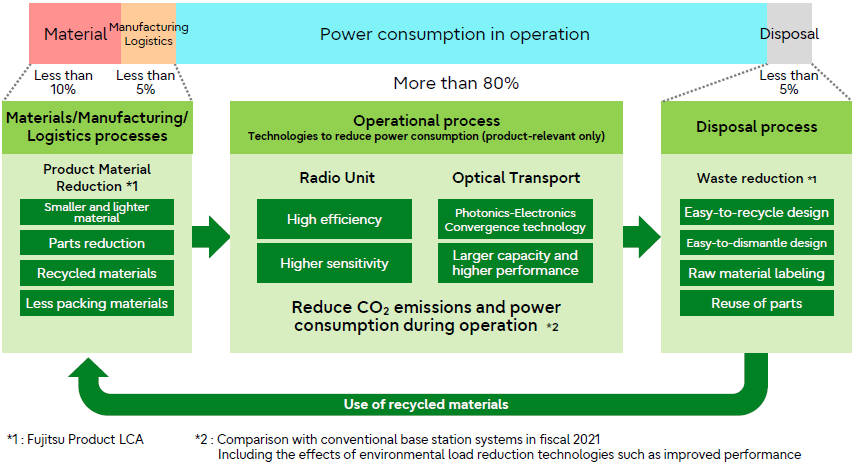 Percentage of CO₂ emissions through the product life cycle
Percentage of CO₂ emissions through the product life cycle
Downsizing of optical transmission equipment
Product downsizing is also one of measures for the reduction of environmental impact. *3 In optical transport system, water cooling technology, which has a proven track record in supercomputers, is adopted instead of conventional air cooling and it enable the reduction of cost for cooing, operation cost of space occupied which leads to the reduction of CO₂ emission by the downsizing of housing.
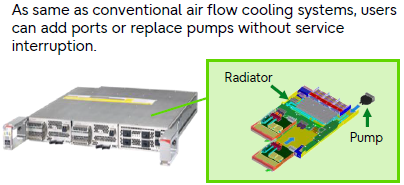 Liquid cooling optical transmission system
Liquid cooling optical transmission system
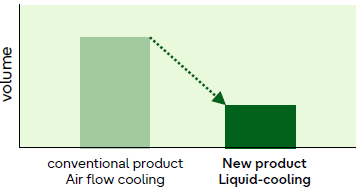 Comparison of volume per transmission capacity
Comparison of volume per transmission capacity
Fujitsu's Initiatives 3 : Collaboration with partners
In collaboration with NTT*4, Fujitsu is engaged in network upgrade and reduction of power consumption in network based on the IOWN*5 concept. The IOWN is the concept of network and information processing infrastructure for a new low-energy, high-efficiency digitalized society.
In this collaboration, joint R&D of disaggregated computing technology is conducted, and it enables high-speed and highly efficient data processing by flexibly combining various hardware with software according to usage.
Disaggregated computing realizes dynamic allocation of resources such as CPU, GPU, and memory with optical connections, aiming for low power consumption and high performance.
As an open community initiative, Fujitsu is participating in the IOWN Global Forum *6 as a sponsor member and has also been elected as the Board of Director through its activities. IOWN GF promotes activities mainly in the area of the Open All Photonics Network Architecture and promotes forum activities with companies that support the IOWN concept. Fujitsu contributes to the community activities through its technologies and solutions.
Fujitsu is focusing on these efforts to reduce CO₂ emissions by customers and society.
Fujitsu aims to achieve its own zero-CO₂ emissions in 2050 and contribute to the realization of carbon-neutral through its technologies and services that support digital innovation.
IOWN is a registered and unregistered trademark of Nippon Telegraph and Telephone Corporation in the United States, Japan, and other countries.
The IOWN GLOBAL FORUM mark and IOWN GLOBAL FORUM & Design logo are trademarks of Innovative Optical and Wireless Network Global Forum, Inc. in the United States and other countries.



